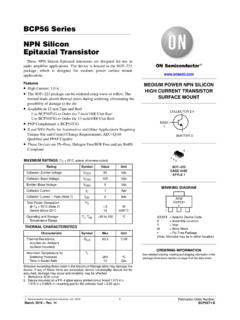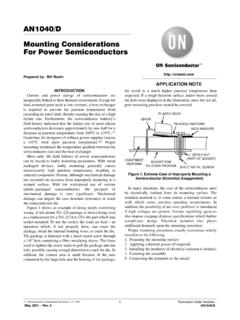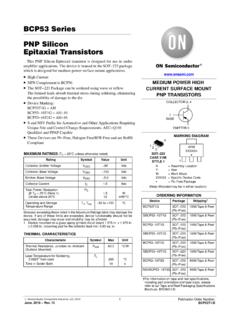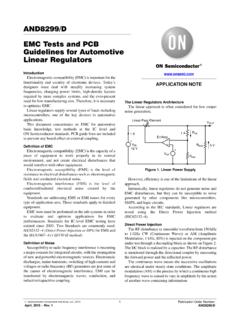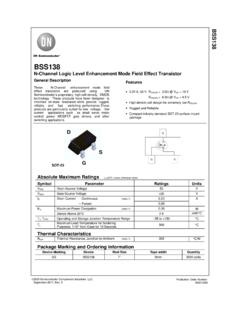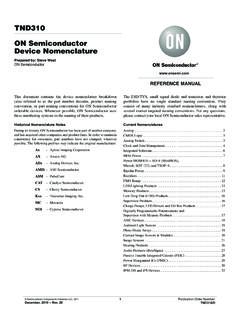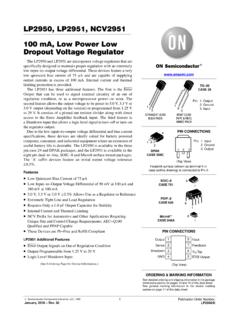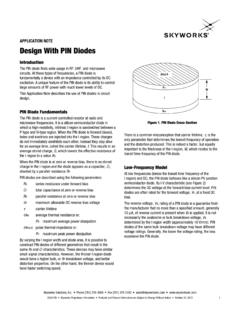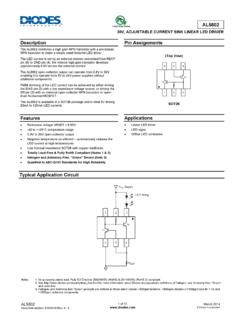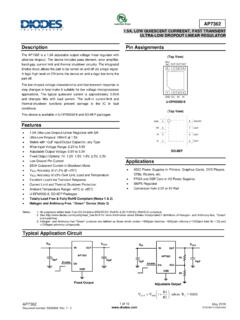Transcription of AND8231 - Circuit Configuration Options for TVS …
1 AND8231 /D. Circuit Configuration Options for TVS Diodes Introduction Transient Voltage Suppression (TVS) protection is APPLICATION NOTE. important because EMI and ESD can disturb the operation of the system, produce permanent damage or cause latent TVS diode Protection Options damage that will eventually cause a failure. Avalanche TVS Figure 1 shows a schematic representation of avalanche diodes and diode arrays are available in a number of different TVS diodes and diode arrays that provide surge protection. Circuit configurations to protect electronic circuits from surge Both types of diode devices can be used for surge voltages. This document will analyze the attributes and suppression; however, each option offers unique protection trade-offs of different Circuit configurations created with features.
2 Tables 1 and 2 provide a summary of the features avalanche TVS and diode array protection devices. of avalanche TVS diode and diode array protection circuits. Bidirectional Avalanche TVS Diodes diode Array VDD VDD. Data_H Data_H. Transceiver Data_L Transceiver Data_L. VDD. NUP2105L. NUP2301. Unidirectional Avalanche TVS Diodes diode Array with Avalanche diode VDD VDD. Data_H Data_H. Transceiver Data_L Transceiver Data_L. VDD. NUP1105L. NUP2201. Figure 1. Schematic Representation of TVS diode Protection Options Semiconductor Components Industries, LLC, 2005 1 Publication Order Number: March, 2017 Rev. 1 AND8231 /D. AND8231 /D. Avalanche TVS Diodes clamping voltage of diode arrays is an advantage for Avalanche diodes are a good TVS device for applications protecting low voltage ICs.
3 The effective minimum that require power line surge immunity and ESD protection. operating voltage of a diode array is limited only by the These devices provide protection by clamping a surge voltage forward voltage drop of a diode . diode arrays can also be to a safe level. They function as a variable impedance to used as line terminators to remove overshoot or ringing on directly absorb the surge energy and maintain a constant high speed data lines. diode data line termination circuits clamping voltage. The avalanche TVS diode 's current and are often called Thevenin networks. voltage characteristics are similar to a Zener diode ; however, Diodes arrays steer the surge current into the power supply there are significant differences between these devices.
4 Rails, as shown in Figure 2. A positive surge pulse will be A TVS diode has a junction that is optimized to absorb the clamped to a voltage that is equal to a forward diode voltage high peak energy of a transient event, while a standard Zener drop above the supply voltage (VDD). Typically the VSS pin diode is designed to clamp a steady state voltage. is grounded; thus, a negative pulse will be clamped to a voltage level one diode drop below ground. The energy of diode Arrays the positive and negative surge pulses is dissipated through diode arrays typically have a moderate power rating and the PCB's power planes. low capacitance. These features make this a popular TVS.
5 Device for data line ESD protection. In addition, the low VDD. P1. +V. D1 clamps positive voltages IP1 D1. VC = VDD + VF. 0V I/O. D2 D2 clamps negative voltages IP2. VC = VSS VF. V. P2. VSS. (VSS is typically connected to Ground). Figure 2. diode Arrays Clamp the Surge Voltage to a diode Drop above or below the Power Rails diode arrays are constructed by combing switching, breakdown voltage slightly higher than the nominal power avalanche and Schottky diodes. Most diode arrays are built supply voltage. The relatively large capacitance load of the with switching diodes in a stacked Configuration ; however, avalanche diode is on the power lines and has only a minor a number of products are available that include an avalanche effect on the frequency response of the data lines.
6 Another diode to increase the surge rating. The switching diodes popular option for diode arrays is to use low turn-on voltage provide a low capacitance load for data lines, while the Schottky diodes to create an effective TVS device for low avalanche diode offers energy dissipation ability for the voltage applications. power line. An avalanche diode is selected that has a 2. AND8231 /D. Table 1. AVALANCHE TVS diode SURGE PROTECTION CIRCUITS. Low Capacitance Low Capacitance Bidirectional Unidirectional Bidirectional Unidirectional Schematic Data Line Data Line Z1. Z1 D1 Z2 D1. Z2 D2. Z1 D2 Z1. Clamping Voltage (VC). VF_Z1 + VBR_Z2 VBR_Z1 VF_D1 + VBR_Z1 VF_D1 + VBR_Z1.
7 Positive Surge (VBR_Z1 + VF_Z2) VF_Z1 (VF_D2 + VBR_Z2) VF_D2. Negative Surge Attributes Solves common Low negative D1 and D2 lower the D1 lowers capacitance mode offset issues clamping voltage capacitance Z1 increases power Direct replacement Z1 and Z2 increase rating for varistors power rating Use with short cables Trade-Offs High capacitance High capacitance Requires four Requires three diodes compared to a compared to a diodes diode array diode array Applications Differential data Single ended data High speed High speed single lines lines differential data ended data lines Use with long Use with short lines cables cables DC power lines DC power lines High frequency Digital logic ICs applications ON Products
8 NUP2105L NUP1105L SL05. NUP4102 NZQA5V6 SL15. Table 2. diode ARRAY SURGE PROTECTION CIRCUITS. diode Array diode Array Plus TVS Schottky diode Array Schematic VDD VDD VDD. D1 D3 D1 D3 D1 D3. I/01 I/02 I/01 I/02 I/01 I/02. D2 D2 Z1 D2. D4 D4 D4. Clamping I/O1 I/O2 I/O1 I/O2 I/O1 I/O2. Voltage (VC). Positive Surge VF_D1 + VDD VF_D3 + VDD VF_D1 + VDDvVCvVZ1_BR VF_D3 + VDDvVCvVZ1_BR VF_D1 + VDD VF_D3 + VDD. Negative Surge VF_D2 VF_D4 VF_D2 VF_D4 VF_D2 VF_D4. Attributes Low capacitance Low capacitance, with moderate power rating Low clamping voltage Good capacitive Z1 increases power rating Low VF ( ^ V). matching (small DC Z1 has minor effect on I/O line capacitance Low VC ensures surge I/O1 to I/O2)
9 Z1 functions as a decoupling capacitor event is clamped by Low clamping voltage external protection Circuit Trade-Offs Poor power rating Z1 is large compared to diodes which increases Power rating is poor compared to avalanche package size compared to a TVS diodes VF ^ V for D1 D4 switching diode VF ^ V Relatively poor reverse bias surge rating Applications Differential data lines Use with single ended data line Differential data lines Use with short cables Use with short cables Use with short cables ESD protection ESD protection ESD protection Low voltage ICs ON Products NUP1301 NUP2201 NUP4302. NUP4301 NUP4201. 3. AND8231 /D. Uni- Versus Bidirectional Protection Avalanche TVS diodes are available in either a uni- or breakdown voltage when reversed biased and a forward diode bidirectional Configuration .
10 In contrast, diode arrays are drop if forward biased. A bidirectional device typically has typically used only as a unidirectional protection device. Uni- a symmetrical VBR for both positive and negative voltages. and bidirectional devices both provide protection against diode arrays can be connected to a positive and negative positive and negative surges; however, the magnitudes of the power supply to create a bidirectional device; however, most breakdown voltages are different, as shown in Figure 3. applications connect the bottom diode to ground which forms A unidirectional device has a clamping voltage equal to the a unidirectional device. Unidirectional TVS Device Bidirectional TVS Device Current Current VBR IF VBR IT.
